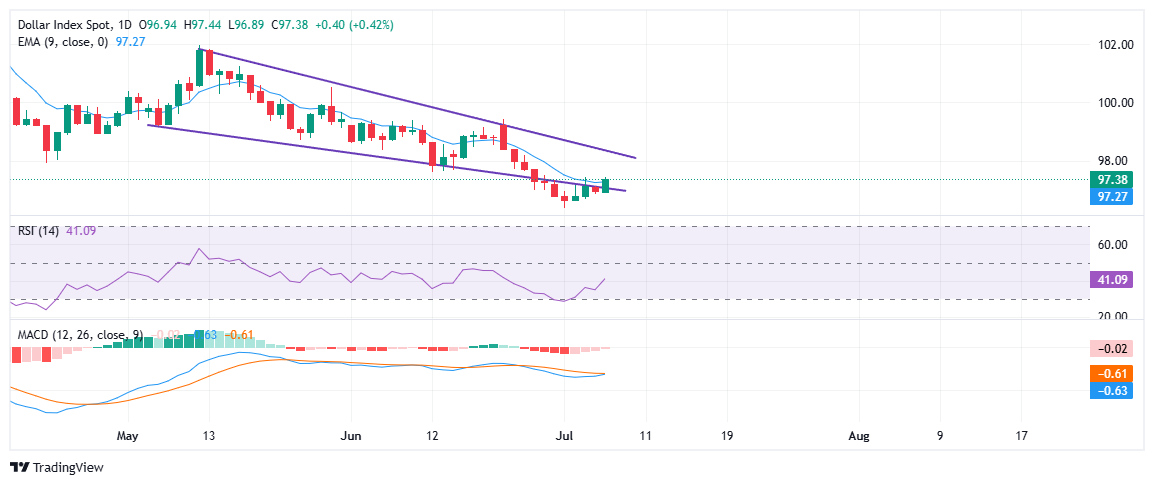US Dollar recovers as market braces for tariff impact
- The US Dollar starts the week higher, supported by safe-haven flows amid tariffs fears.
- The US is set to formally notify over 100 countries of new tariffs by July 9, with implementation scheduled for August 1.
- The US Dollar (DXY) rises back inside a falling wedge pattern, with RSI and MACD showing signs of bullish momentum building.
The US Dollar (USD) kicks off the week on a firmer footing against its major peers, underpinned by safe-haven demand and reduced odds of near-term Federal Reserve (Fed) interest rate cuts. Risk sentiment sours as markets brace for the July 9 deadline, when the United States (US) is expected to formally notify trading partners of sweeping new tariffs potentially as high as 70%, targeting over 100 countries.
The US Dollar Index (DXY), which measures the value of the Greenback against a basket of six major currencies, is ticking higher during early American trading hours. At the time of writing, the index is trading around 97.40, near the previous week’s high, and up 0.45% on the day, as investors favor the US Dollar amid lingering global trade tensions and cautious market sentiment.
With the July 9 deadline just around the corner, US President Donald Trump has dialed up his tariff campaign. On Sunday, he said that the US would begin sending out final and non-negotiable tariff letters to countries starting Monday. According to Trump, around 12 to 15 letters would go out on the first day, with more to follow. These letters will outline tariff rates that vary depending on the country’s trade history, ranging from 10%–20% and potentially going up to 70%.
Ongoing trade tensions and policy uncertainty from Washington have drawn strong criticism from BRICS nations (Brazil, Russia, India, China, and South Africa), who also condemned recent US and Israeli military strikes on Iran. In a joint statement following their summit in Rio de Janeiro on Sunday, the bloc expressed “serious concerns about the rise of unilateral tariff and non-tariff measures,” which they deemed “inconsistent with WTO (World Trade Organization) rules.”
In response, President Trump doubled down, declaring on Sunday that any country aligning with what he described as the “anti-American policies” of the BRICS bloc would face an additional 10% tariff. “There will be no exceptions to this policy. Thank you for your attention to this matter!” Trump posted on Truth Social. The strong rhetoric has further unsettled markets, reinforcing the Greenback’s appeal as investors seek safety amid rising geopolitical and trade-related risks.
Market Movers: Tariff uncertainty, rate cut repricing
- The US Dollar is attempting a recovery on Monday after falling to its lowest level in over three years last week. The Greenback has been under consistent pressure throughout the first half of 2025, with the US Dollar Index (DXY) plunging more than 10% marking its steepest six-month drop in over 50 years. The decline has been fueled by growing concerns over mounting fiscal deficits, escalating tariff tensions, and diminishing confidence in the safe-haven appeal.
- Economists point to US President Trump’s unpredictable economic policies as a key driver behind the market’s cautious stance on the US Dollar. A recent Reuters poll conducted on July 2 found that around 37% of FX analysts view tariff negotiations as the key factor weighing down the US dollar, alongside concerns over US debt and interest rate trajectory.
- As the US Dollar stages a modest rebound, major global currencies are coming under renewed pressure amid escalating trade uncertainty and reduced expectations of near-term Fed interest rate cuts. EUR/USD is down 0.40%, trading around 1.1725, while GBP/USD has slipped 0.38% to 1.3595. Commodity-linked currencies are facing steeper losses, with AUD/USD falling 0.90% to 0.6496 and NZD/USD down 1% at 0.5996. In Asia, the Chinese Yuan, South Korean Won, and Indian Rupee have also weakened, as safe-haven flows into the Greenback continue to dominate amid growing market caution.
- The benchmark 10-year US Treasury yield held firm at around 4.35% on Monday, up slightly from Friday’s close of 4.30%. The steady rise in yields reflects investors’ reduced expectations for near-term Fed rate cuts, particularly amid rising inflation risks associated with US tariffs. While the safe-haven appeal of the US Dollar is supporting it, elevated yields are also providing fundamental support, keeping the Greenback well bid across major currencies.
- Top US officials have reaffirmed that the next wave of tariffs will go into effect on August 1, adding urgency to ongoing trade talks. Commerce Secretary Howard Lutnick said over the weekend that while President Trump is currently “setting the rates and the deals,” the implementation timeline is firm. “Tariffs go into effect August 1,” Lutnick told reporters.
- Treasury Secretary Scott Bessent cautioned that countries failing to reach agreements by the deadline will revert to previously set tariff levels. “If you don’t move things along, then, on August 1, you will boomerang back to your April 2 tariff level,” Bessent said during a CNN interview.
- With the July 9 tariff notification deadline approaching, market anxiety is on the rise. So far, only China, the United Kingdom (UK, and Vietnam have secured preliminary trade agreements with Washington, gaining partial relief from the looming tariff hike scheduled to take effect on August 1. Under these deals, tariff rates have been reduced but not eliminated, reflecting the US administration's tough stance.
- Investor expectations for a near-term Fed interest rate cut have shifted significantly following June’s stronger-than-expected employment report. The US economy added 147,000 jobs last month, beating forecasts, while the unemployment rate dipped to 4.1%. The robust data has led markets to scale back bets on a July rate cut, with futures now showing less than a 5% probability. The focus has shifted toward September as the earliest likely window for policy easing. According to the CME FedWatch Tool, there is now a 66% probability that the Fed will lower rates to the 4.00%–4.25% range at its September meeting.
Technical Analysis: US Dollar Index reenters wedge pattern, momentum indicators hint at reversal 
The US Dollar Index (DXY) is showing early signs of a technical recovery after briefly breaking below a well-defined falling wedge pattern last week. The breakdown appeared to be short-lived as the index has climbed back inside the wedge, hinting at a potential bear trap. The DXY is currently trading around 97.40, just above the 9-day Exponential Moving Average (EMA) at 97.28. A sustained move above the EMA would strengthen the bullish case, with the next upside target seen near the upper boundary of the wedge pattern, currently around 97.85–98.50.
Momentum indicators are also showing early signs of improvement. The Relative Strength Index (RSI) has bounced to 41.09 on the daily chart, rising from oversold territory, although it remains below the neutral 50 mark. Meanwhile, the MACD remains in negative territory but is converging toward a bullish crossover, with the histogram turning less negative.
If the DXY can hold above the 97.00–97.20 support zone and break above the wedge resistance near 98.00, it could trigger a stronger rebound. However, failure to sustain this momentum could drag the index back below Friday's low of 96.86, exposing it to renewed downside risk.

